Your Guide To The Ear Piercing Healing Time & After-Care
Your Guide To The Ear Piercing Healing Time & After-Care
If you’re thinking about getting a piercing, it’s important to prepare to care for it properly. Ear stacking has gained popularity over the past few years and, even amid a pandemic, provided us with a personalized creative outlet. Piercing studios are everywhere now, which makes it simple to continuously embellish your ear party. Whether you’re thinking about getting your first ear piercing or seeking to enhance your curated ear, it’s important to know what to expect when it comes to pain, healing time and after-care.
Different types of ear piercings come with various levels of patience and maintenance. They range from a simple standard lobe piercing (minimal healing time) to different types of cartilage piercings (which take considerably longer to heal).
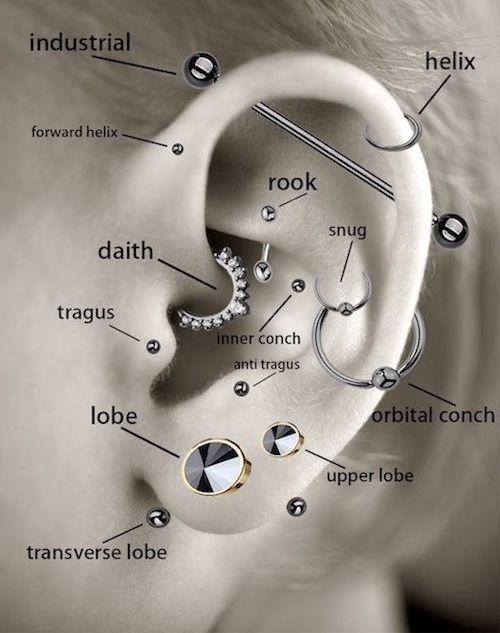
Credit: Fresh Trends/Pinterest
Here’s a full guide to the healing times for the top ear piercing types and best after-care practices you must know.
Standard Lobe Piercing
Healing Time: 6-8 Weeks
When you think of ear piercings, a standard lobe piercing is probably the first placement that comes to mind. The standard lobe piercing is widely considered the least painful ear piercing. Its relatively low pain level makes this lobe piercing the perfect entry-level option – whether you’ve had one for decades or just decided to dive into the world of ear piercings. Lobe piercings are located on the fleshy part of the ear. So, unlike a cartilage piercing, a standard lobe piercing should fully heal in 1-2 months and be relatively low maintenance. Depending on the size of your ear, you can get up to 3-4 stacked lobe or lobe constellation piercings.
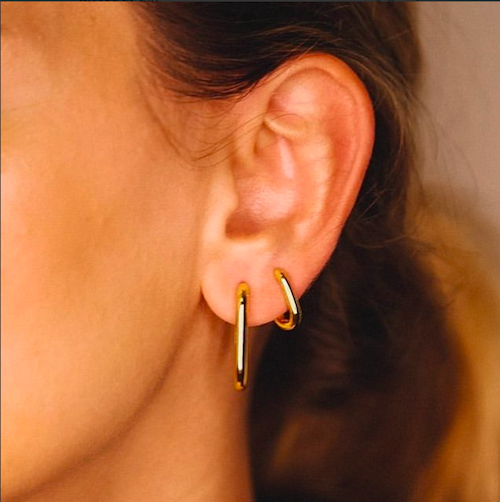
Credit: @letsearparty/Instagram
Transverse Lobe Piercing
Healing Time: 2-10 Months
A transverse lobe piercing is threaded from side-to-side using a barbell earring (unlike a standard lobe piercing that is pierced from front to back). A transverse lobe piercing will look and be done differently, depending on if you have attached or detached lobes. If you have attached lobes, your piercing will appear curved. Your piercer will also probably use a curved needle to pierce your lobe. If you have detached lobes, your piercing should appear straight. Your piercer will likely use a straight needle to do your transverse lobe piercing.
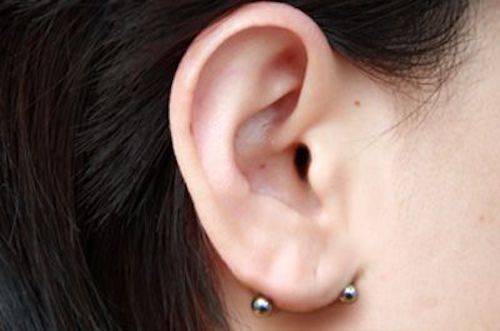
Credit: BodyCandy Body Jewelry/Pinterest
Helix Piercing
Healing Time: 3-6 Months
Any piercing on the outer cartilage is considered a helix piercing. Typically, though, a helix piercing is placed on the upper outside rim of the ear. A stacked helix can elevate any ear party. You can get a double or triple helix piercing if you would like (your piercer will advise you whether you should get more than one done at a time). Helix piercings are generally considered the least painful among the different types of cartilage piercings available. However, like any cartilage placement, helix piercings take considerably longer to heal than lobe piercings. The initial healing stage for a helix piercing will last for around 3-4 months. During this time, the piercing will appear healed on the outside. However, it will take about 6-12 months to fully heal.
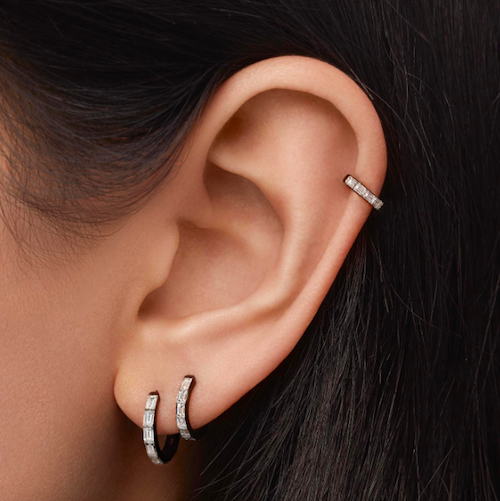
Credit: @mariatash/Instagram
Forward Helix Piercing
Healing Time: 3-9 Months
A forward helix piercing is placed on the frontal outer cartilage of the ear, right above the tragus. Once they’ve healed, forward helix piercings are very low-maintenance. So, as long as you’re diligent with your initial after-care routine, it’s unlikely that they will cause an infection or unforeseen irritation. You can get double or triple forward helix piercings for a more dynamic look. Forward helix piercings generally rate at a 5-6/10 on the pain scale.
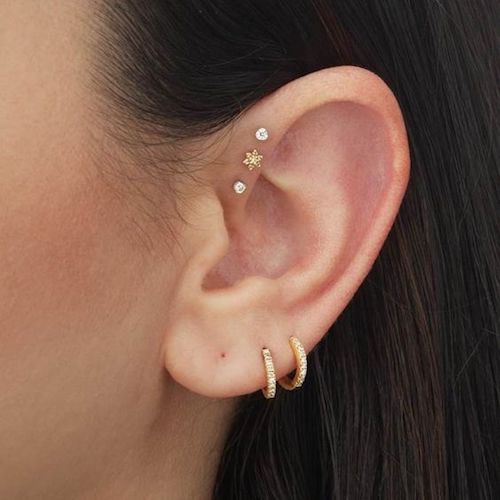
Credit: ELLE Australia/Pinterest
Daith Piercing
Healing Time: 3-9 Months
A daith piercing is done on the small flap of cartilage on the inner, right above the ear canal. Daith piercings are known for their potential health benefits and ability to help those suffering from regular migraines. Like any cartilage piercing, daith piercings can appear healed on the outside within 3-4 months. However, a daith piercing can take up to 6-12 months to fully heal. Because it's on the inner ear, you can sleep on the side of your daith piercing after only a couple of months into the healing process.
Daith piercings are typically more painful to get pierced than a helix or lobe piercing because the cartilage on this area is thicker. Expect a duller sensation when getting this cartilage pierced.
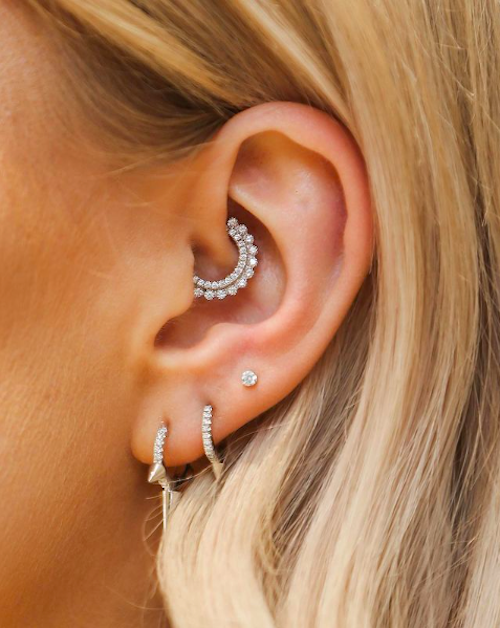
Credit: @mariatash/Instagram
Conch Piercing
Healing Time: 6-9 Months
There are two types of conch piercings: an inner conch and an outer conch piercing. They are both located on the cartilage next to the curvature of your ear. An inner conch piercing is done higher up on the cartilage, directly in the middle of the ear (parallel to a daith placement). An outer conch piercing is placed lower, near the anti-helix (snug piercing). Your piercer will help you determine whether an inner or outer conch piercing is best for your ear shape. The average healing time for a conch piercing is 6-9 months. In some cases, it can take up to 12 months for the cartilage to fully heal.
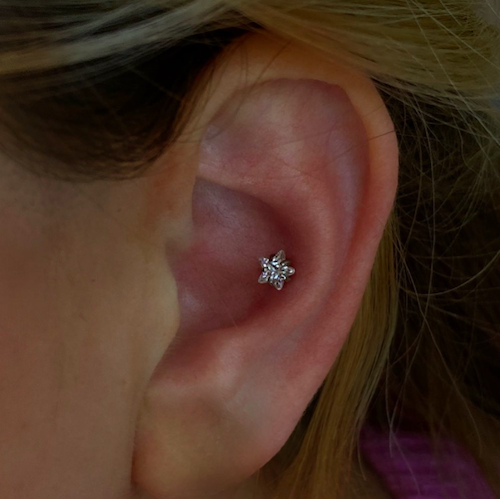
Credit: @thaisbarss/Instagram
Flat Piercing
Healing Time: 6-10 Months
Like its name, the flat piercing is located on the smooth cartilage below the ear’s upper outer rim. You can get single or multiple flat piercings (double or triple, either stacked or mismatched, to create a flat constellation) to elevate your ear party. Flat piercings are done on an area with thicker cartilage, so expect a little more pain and a longer healing time with this placement than those done on thinner cartilage (like a helix piercing). Flat piercings tend to rate as 6-7/10 on the pain scale (less than a snug, rook or industrial piercing). However, the pain level for any piercing is subjective. The average healing time for a flat piercing is 6-10 months. As with any cartilage piercing, it can take up to a year for your flat piercing to fully heal.
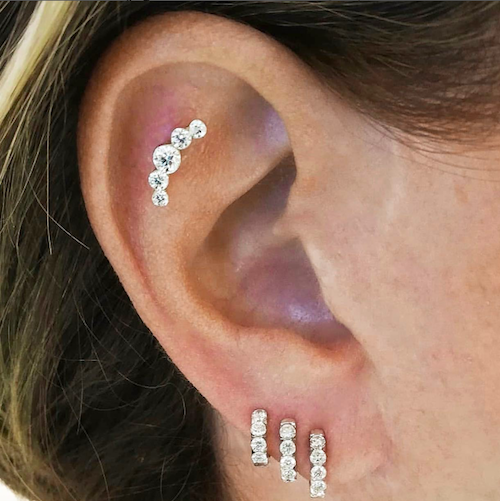
Credit: @mariatash/Instagram
Tragus Piercing
Healing Time: 6-12 Months
A tragus piercing is done on the small section of cartilage over the entrance to the ear canal. Tragus piercings offer a subtle, edgy look that can easily be adorned with a small stud or charm. The average healing time for a tragus piercing is around 6-12 months. Wait at least 2 months, while following the proper after-care protocols, to start sleeping on the side of a tragus piercing. Avoid using earphones or earbuds during the first 1-2 months after getting your tragus pierced. They can irritate the area and potentially cause an infection. A tragus piercing rates at around a 4/10 on the pain scale. It is one of the less painful cartilage ear piercings with a similar pain level to a helix piercing.
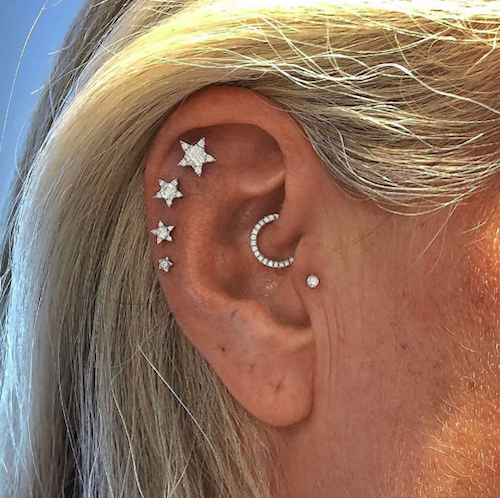
Credit: @mariatash/Instagram
Anti-Tragus Piercing
Healing Time: 6-12 Months
An anti-tragus piercing is done on this small, curved area of cartilage located between your earlobe and tragus. Anti-tragus piercings take 6-12 months to fully heal. This cartilage placement is one of the most sensitive piercings you can get. Don’t use earphones, earbuds or sleep on the side of your anti-tragus piercing for at least 6 months. Anti-tragus piercings typically rate at a 6-7/10 on the pain scale (similar to the pain of a flat piercing).
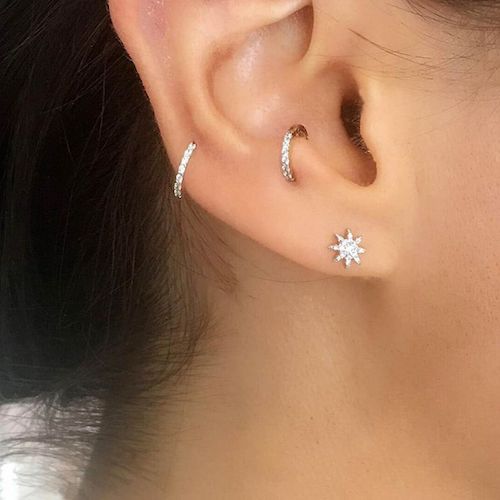
Credit: ELLE Australia/Pinterest
Snug Piercing
Healing Time: 6-12 Months
Also known as the anti-helix, a snug piercing is done on the cartilage between the outer ear ridge and inner conch. While attractive, not everyone can get a snug piercing. Your piercer will let you know whether your ear anatomy makes you eligible for a snug piercing. Snug piercings heal in around 4-6 months (at least on the outside). But like most cartilage piercings, snug piercings can take between 6-12 months to fully heal. On the pain scale, snug piercings generally rate a 9/10 and are considered one of the most painful ear piercings you can get.
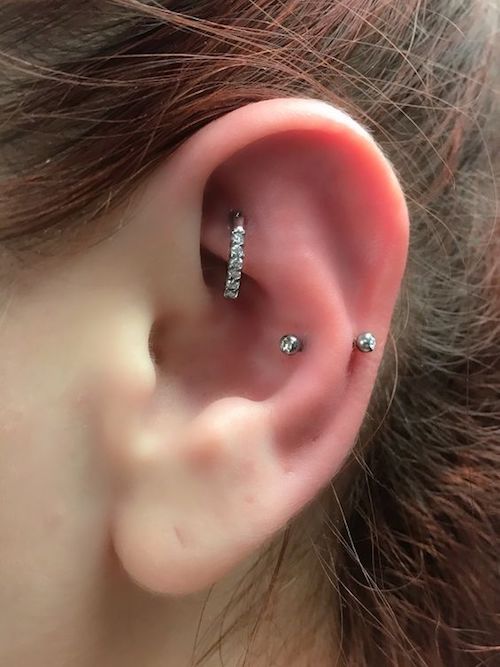
Credit: Body Piercing By Qui Qui/Pinterest
Orbital Piercing
Healing Time: 8-10 Weeks (2-3 Months)
An orbital piercing describes any two holes connected by a hoop. They are typically done on the ear lobe, but they can also be done towards the middle of the ear (along the helix). Orbital piercings have the average shortest healing time, 8-10 weeks, aside from a standard lobe piercing. However, when getting an orbital piercing done on your cartilage, it will take around 6-12 months to heal. Orbital piercings rank at an approximate 4-5/10 on the pain scale. The pain level can vary depending on your personal tolerance and the placement of your piercing.
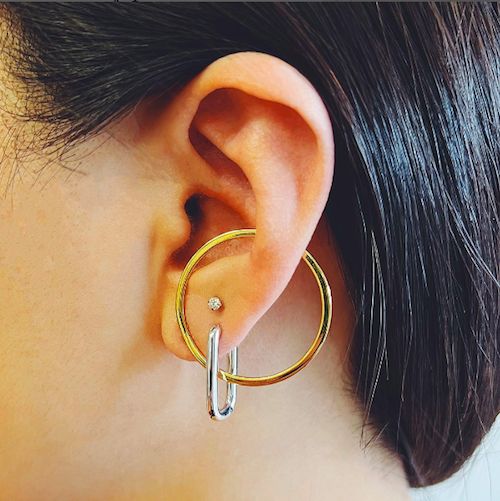
Credit: @letsearparty/Instagram
Rook Piercing
Healing Time: 6-12 Months
A rook piercing is placed on the upper ridge of cartilage on the inner ear. Rook piercings offer a unique alternative to more popular placements, like a tragus or daith piercing, ensuring that your ear party stands out. As with any cartilage piercing, a rook piercing should take around 6-12 months to fully heal. While proper after-care is essential, don’t worry about sleeping on your rook piercing almost immediately – thanks to this placement’s location on the inner ear. Rook piercings are among the most painful ear piercings (ranking at a 6-8/10 on the pain scale) but often hurt less than placements like a snug piercing. It depends on your ear anatomy and pain tolerance.

Credit: @letsearparty/Instagram
Industrial Piercing
Healing Time: 6-12 Months
Industrial piercings refer to any two holes connected by a barbell earring. However, a standard industrial piercing typically refers to two cartilage piercings on the upper ear joined together with a barbell. The average healing time for industrial piercings is 6-12 months due to the placement and thickness of the cartilage in this area. On the pain scale, an industrial piercing generally ranks at around a 7/10.
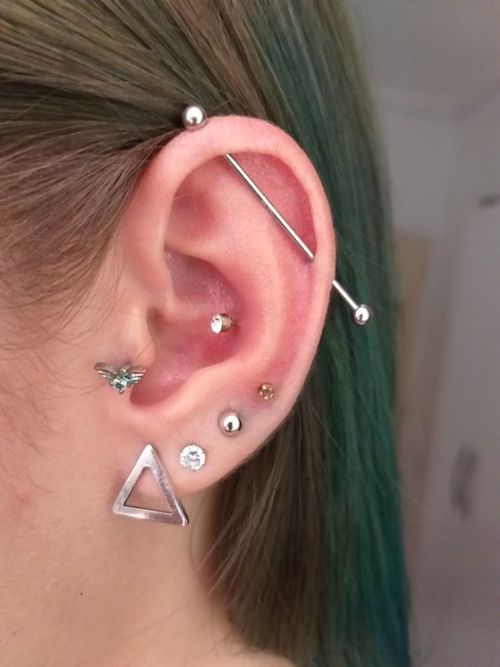
Credit: pam/Pinterest
Lobe Piercing After-Care:
During the healing process, clean the piercing daily with a saline solution, fragrance-free soap or another product recommended by your piercer. Dry with a clean paper towel. Always wash your hands with soap and water before touching or cleaning your piercing. Repeat this cleaning routine 2-3 every day for around a month after getting your piercing. When cleaning your lobes, do a 360-degree twist with the earring(s) to ensure the area remains fresh and the holes stay open.
Cartilage Piercing After-Care:
Cartilage piercings take longer to heal and are more prone to side effects like irritation, infection, bumps (such as keloids, overgrowth of scar tissue) and swelling than lobe piercings. So, you will need to take extra care during the after-care process when tending to a cartilage piercing. Clean your piercing 2-3 times daily with a saline solution or fragrance-free soap (as recommended by your piercer). Pat dry with a fresh paper towel. Wash your hands every time before touching or washing your piercing. Never twist the jewelry when cleaning a cartilage piercing. Turning any jewelry in a cartilage piercing can cause scarring or delay healing during the healing process.
Before considering a piercing, it’s important to take note of your personal pain tolerance. If you’re nervous about the pain, ask your piercer whether you can use a numbing cream for your session. Zensa Numbing Cream contains 5% lidocaine to minimize pain without any vasoconstrictors, making it a safe option to use before piercing procedures. This product should provide a numbing effect on the skin for 2-3 hours after application and is a vegan, steroid-free formula.
During the healing process, include Zensa Healing Cream into your ear piercing after-care routine to improve the recovery process. Confirm with your piercer to ensure these ingredients support your healing journey.
Ear Piercing Guides:
12 Top Ear Piercings & You Guide To Each One
The Least To Most Painful Types of Ear Piercings, Ranked
Your Guide To Cartilage Ear Piercings: 10 Types To Know
The Best Piercing Ideas For Your Face Shape
Top Piercing Ideas To Try In 2022 For Your Unique Ear Shape
For more curated ear ideas, check out cute ear-piercing combinations HERE, HERE and HERE.

